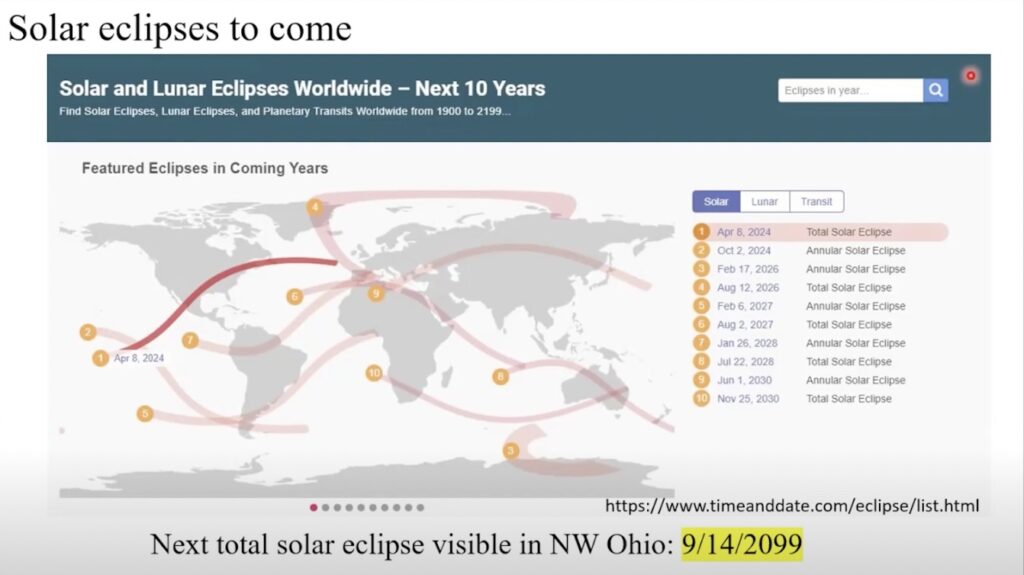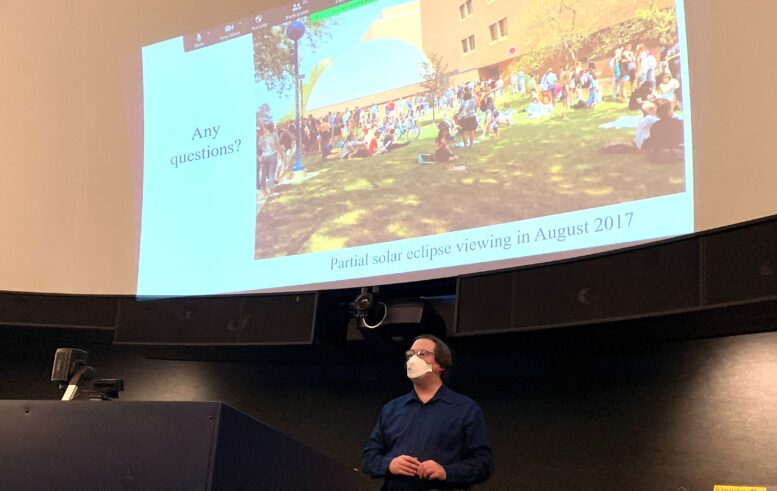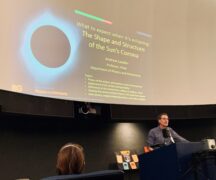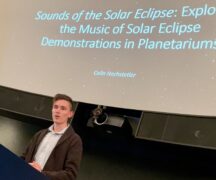By JULIE CARLE
BG Independent News
Before astronomers understood what caused solar eclipses, ancient civilizations had their own beliefs about the mystery of the sun’s sudden but short disappearance during the day.
“An eclipse is a very striking event in the sky, even when we know what’s going on,” Dr. Allen Rogel said during a recent Eclipse Speaker Series talk at the Bowling Green State University Planetarium.
So imagine what early civilizations thought when once in a great while, in a fraction of a day, there would be a bite taken out of the sun before it completely disappeared, only to be replaced by a black hole in the sky, surrounded by a ring of fire.
Because many ancient civilizations were agrarian and knew the sun’s importance in their daily life, they thought of the sun as a divine being, which led to cultures placing high importance on the existence of the sun, explained Rogel, who is a teaching professor in the Department of Physics and Astronomy.
“Given the importance of the sun in ancient society, it was terrifying times,” he said.
For many, an eclipse signaled a fearful omen of oncoming disaster—from the end of a dynasty to the destruction of the entire world.
In China, the common thought was that a dragon was coming to eat the sun, leaving a message that the ruling family’s empire was over. To scare away the dragon, the dynastic ruler had his people yelling, screaming and banging drums to scare off the creature.
“And lo and behold, it worked,” he said, referencing the sun’s return at the end of the eclipse. “It became the standard response” and the ruler’s regime was saved.
The Norse believed two wolves, known as Skoll and Hati, were hungry for celestial bodies. Skoll would chase the sun and Hati would chase the moon. Skoll would catch up to the sun during a solar eclipse and Hati would try to eat the moon during a lunar eclipse. The Vikings believed if the wolves were successful, it would be Ragnarok, the end of the world. Their response was similar to the Chinese; they would scream and yell to scare the wolves away.
Hindu, Aztec and Mayan beliefs about eclipses also were founded in fear of what would happen if the sun or moon completely disappeared, Rogel said.
Instead of fearing gods or dragons, the Inuits believed the sun was sick, he said. “They didn’t want to catch anything from the sun, so they hid until the sun was healed up into full glory a few hours later.”
The Ojibwe tribes in the Great Lakes region thought the sun was like a campfire that had gone out. Instead of hiding or banging drums, they used fire arrows aimed at the sun.
“Eventually one of the arrows would launch high enough to reignite the sun,” he said. “It wasn’t quite as devastating of an omen, but it still required human intervention to fix the problem.”
Some cultures, such as the Celtics, Navajo and Pacific Islanders, viewed eclipses in a more positive light. The Celtic people, who understood the sun and moon aligned, believed the eclipse to be an open gateway to the spiritual realm, allowing them to easily communicate with the spirits.
Eclipses were thought to be the death and rebirth of the sun for Navajo people. “It’s a very solemn time for them, filled with meditation and prayer during the sun’s rebirth,” Rogel said.
The Pacific Islanders believed an eclipse was “a signal from the gods to shape up, quit arguing with one another, work out their differences and get back to being peaceful people. It was a knock in the head to shape up,” he joked.

Eclipse predictability changed over time
Those early interpretations were considered random events. There was no concept that solar eclipses happened in a periodic predictable fashion, but that was understandable, given the nature of eclipses, Rogel said.
With partial eclipses, the signs are much less obvious than during a total eclipse, and the path of a total eclipse is limited. “You have to be near the center to get the total effect,” he said. Human eyes adapt in areas that aren’t in totality.
“To record periodic events that you don’t see very often becomes very problematic if you are missing most of them,” he said.
The first eclipse prediction, recorded by Greek historian and geographer Herodotus, was between 590 BCE (Before the Common Era) and 585 BCE by Thales of Miletus. Thales, a philosopher, was said to have predicted the year of the eclipse; however, there was some dispute that he would have had the skills and information to predict the eclipse.
“He might have gotten lucky, or it was due to a temporary random, quasi-periodic pattern in local solar eclipses in the last half-century. You can get periodic sequences even in a random series of numbers,” Rogel reasoned.
Instead, patterns of recurring eclipses have been determined through long-term recordkeeping. After hundreds of years of detailing eclipse occurrences, eclipse predictions are founded upon what’s called the Saros Cycle.
Chaldean astronomers of the second Babylon empire (620 BCE to 539 BCE) discovered the patterns from records of earlier astronomers. Later Greek astronomers and the Chinese also recognized the patterns.
Eclipses are possible when the Earth is in the right place in its orbit of the sun and the moon is in the right place in its orbit around the Earth. However, it takes 18 years, 11 days and 8 hours to reach the same alignment, which is the actual cyclical pattern of the Saros Cycle, he said.

There are many Saros Cycles. “For the April 8 eclipse, you have to go back three Saros Cycles to be in the proper position for the United States to actually see the eclipse,” he said. The paired eclipse, visible in the U.S. on the East Coast was on March 7, 1970. The next visible eclipse in Ohio will be Sept. 14, 2099.
Today astronomers can predict eclipses out hundreds of years. “We know when eclipses are going to happen in the year 3000 CE,” he said. The predictions are based on Saros Cycles but are much more complex thanks to computer simulations and modeling.
There are many eclipse tracks that take place at different precessions of the moon’s orbit around the earth. “If you have a good budget, you can see a lot of eclipses in a fairly short span of time, you just have to fly to the right place,” he said. “In fact, solar and lunar eclipses are equally as common, it’s just that the solar eclipse is viewed from a smaller portion of the earth, and for the lunar eclipse the entire night side of the planet can see when the moon enters the earth’s shadow.”





